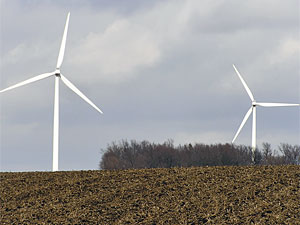Saturday, May 5, 2012
US claims 'unprecedented' success in test for new fuel source
By Miguel Llanos, msnbc.com
Could the future of cleaner fossil fuel really be frozen crystals now trapped in ocean sediments and under permafrost?
Backed by an oil industry giant, the Obama administration recently tested a drilling technique in Alaska's Arctic that it says might eventually unlock "a vast, entirely untapped resource that holds enormous potential for U.S. economic and energy security." Some experts believe the reserves could provide domestic fuel for hundreds of years to come.
Those crystals, known as methane hydrates, contain natural gas but so far releasing that fuel has been an expensive proposition.
The drilling has its environmental critics, but there’s also a climate bonus: The technique requires injecting carbon dioxide into the ground, thereby creating a new way to remove the warming gas from the atmosphere.
Advertise | AdChoices
"You're storing the CO2, and also liberating the natural gas," Christopher Smith, the Energy Department's oil and natural gas deputy assistant secretary, told msnbc.com. "It's kind of a two-for-one."
The Energy Department, in a statement last week, trumpeted it as "a successful, unprecedented test" and vowed to pump at least $6 million more into future testing.
"While this is just the beginning, this research could potentially yield significant
new supplies of natural gas," Energy Secretary Steven Chu announced.
ConocoPhillips, the oil company that worked on the test at its oil facility in Alaska's North Slope, was hopeful the technique could become economically feasible for producing natural gas, a fuel that's much cleaner than petroleum.
"Many experts believe that methane hydrates hold significant potential to supply the world with clean fossil fuel," spokesman Davy Kong told msnbc.com. "The completion of this successful test of technology is an important step in developing production technology to access this potential resource while sequestering carbon dioxide."
But even the CO2 bonus doesn't convince environmentalists worried about a reliance on fossil fuels -- the key source for manmade carbon dioxide emissions.
"Finding new ways to produce fossil fuels doesn't change the fact that we can't transfer to the atmosphere all the carbon in the fuels we already have without causing catastrophic climate disruption," Dan Lashof, a climate analyst with the Natural Resources Defense Council, told msnbc.com.
"Rather than perpetually seeking new sources of fossil fuel, our federal research dollars should be going into carbon-free energy sources" like solar and wind, added Brendan Cummings, public lands director at the Center for Biological Diversity, a group that's tied climate impacts to its petitions to protect wildlife.
Cummings also worries about inadvertent releases of methane, which is even more powerful as a warming gas than CO2.
Alaska's Arctic is the U.S. area "most under stress from warming," he added. "Even if we could safely develop and install infrastructure there, we're still industrializing an area that essentially should be left alone."
Methane hydrate fans include Vladimir Romanovsky, a permafrost expert at the University of Alaska-Fairbanks.
It has "great potential and not much danger" compared to conventional natural gas, he said. "Extracting energy and sequestering CO2 is win-win situation."
Sen. Lisa Murkowski of Alaska, the ranking Republican on the Senate energy committee, noted that future testing needs to look at issues like soil stability, but overall she was bullish.
"If we can bring this technology to commercialization, it would truly be a game changer for America," she said in a statement.
"Taken together, U.S. lands and waters contain a quarter of the world’s methane hydrates -- enough to power America for 1,000 years at current rates of energy consumption," her office added.
Related: US wants 'fracking' on fed lands to list chemicals
Alaska alone could hold 600 trillion cubic feet of methane hydrates onshore, the office stated, citing U.S. Geological Survey estimates. That's potentially three times more than the known natural gas deposits in Alaska.
The state also estimates a whopping 200,000 trillion cubic feet of methane hydrates lie under Alaskan waters. That reflects that fact that the vast majority of methane hydrates -- the U.S. Geological Survey estimates 99 percent -- are in ocean sediments.
Read more at:
http://usnews.msnbc.msn.com/_news/2012/05/05/11522433-us-claims-unprecedented-success-in-test-for-new-fuel-source?lite
Top of blog:
Subscribe to:
Post Comments (Atom)



No comments:
Post a Comment